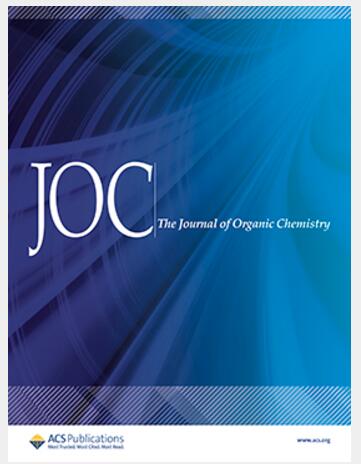溴磷酸作为手性磷酸催化剂失活的一种方式——动力学分析。
IF 3.6
2区 化学
Q1 CHEMISTRY, ORGANIC
引用次数: 0
摘要
动力学分析表明,在环己烯催化溴酯化反应过程中,二醇衍生的手性磷酸(R)-1失活。失活的产物被鉴定为非对映异构体磷酸盐(R,1R,2R)-3a和(R,1S,2S)-3b,它们是通过烯烃溴化过程形成的,其中1的磷酸盐表现为竞争性亲核试剂,从化学计量溴化反应中得到3a和3b的真实制备证实。非对映异构体的高效液相色谱分离得到纯3a,其绝对构型和相对构型通过单晶x射线衍射得到证实。磷酸盐3a的31P{1H} NMR谱显示出4个共振,尽管3a只有一个磷原子,结合vtt -NMR和DFT分析表明,这是9-菲(Ar)的C3,3'-Ar键旋转异构的结果。此外,利用变时间归一化分析(VTNA)对催化环己烯溴化反应进行的动力学研究表明,所有反应物都具有一级动力学。在催化溴酯化条件下形成的磷酸盐3a和3b的量被量化,从而可以跟踪催化剂1的时间浓度,从而阐明催化剂1的一级动力学。提出了一个与这些观察结果相一致的催化循环。本文章由计算机程序翻译,如有差异,请以英文原文为准。
Bromophosphatation as a Mode of Chiral Phosphoric Acid Catalyst Deactivation as Elucidated by Kinetic Profiling.
A BINOL-derived chiral phosphoric acid (R)-1 was shown by kinetic profiling to be deactivated during the catalytic bromoesterification of cyclohexene. The products of the deactivation were identified as diastereoisomeric phosphates (R,1R,2R)-3a and (R,1S,2S)-3b and are formed via an alkene bromophosphatation process where the phosphate of 1 behaves as a competitive nucleophile, as confirmed by authentic preparations of 3a and 3b from a stoichiometric bromophosphatation reaction. HPLC separation of the diastereoisomers gave pure 3a whose absolute and relative configurations were proven by single-crystal X-ray diffraction. The 31P{1H} NMR spectrum of phosphate 3a displayed four resonances despite 3a having just one phosphorus atom, and combined VT-NMR and DFT analysis revealed this to be a consequence of rotational isomerism about the 9-phenanthrene (Ar) bearing C3,3'-Ar bonds. Moreover, kinetic studies using variable time normalization analysis (VTNA) of the catalytic cyclohexene bromoesterification showed first order kinetics in all reactants. The amount of phosphates 3a and 3b formed under catalytic bromoesterification conditions was quantified, enabling tracking of the temporal catalyst 1 concentration and hence elucidation of first order kinetics in catalyst 1. A catalytic cycle consistent with these observations is proposed.
求助全文
通过发布文献求助,成功后即可免费获取论文全文。
去求助
来源期刊

Journal of Organic Chemistry
化学-有机化学
CiteScore
6.20
自引率
11.10%
发文量
1467
审稿时长
2 months
期刊介绍:
Journal of Organic Chemistry welcomes original contributions of fundamental research in all branches of the theory and practice of organic chemistry. In selecting manuscripts for publication, the editors place emphasis on the quality and novelty of the work, as well as the breadth of interest to the organic chemistry community.
 求助内容:
求助内容: 应助结果提醒方式:
应助结果提醒方式:


